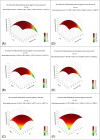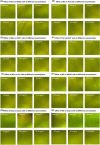Production, characterization and biomedical potential of biosurfactants produced by haloalkaliphilic archaea from Wadi El-Natrun, Egypt
- PMID: 38486239
- PMCID: PMC10941367
- DOI: 10.1186/s12934-024-02351-y
Production, characterization and biomedical potential of biosurfactants produced by haloalkaliphilic archaea from Wadi El-Natrun, Egypt
Abstract
Extreme halophilic archaea that can live in high saline environments can offer potential applications in different biotechnological fields. This study delves into the fascinating field of halophilic archaea and their ability to produce biosurfactants. Some strains of haloarchaea were isolated from Wadi El-Natrun and were screened for biosurfactants production in a standard basal medium using emulsification index assay. Two strains were chosen as the potential strains for surface tension reduction. They were identified as Natrialba sp. BG1 and N3. The biosurfactants production was optimized and the produced emulsifiers were partially purified and identified using FTIR and NMR. Sequential statistical optimization, Plackett-Burman (PB) and Box-Behnken Designs (BBD) were carried out using 5 factors: oil, NaCl, casamino acids, pH, and inoculum size. The most significant factors were used for the next Response Surface Methodology experiment. The final optimal conditions for biosurfactants production were the inoculum size 2% pH 11 and NaCl 250 g/L, for Natrialba sp. BG1 and inoculum size 2.2%, pH 10 and NaCl 100 g/L for Natrialba sp. N3. The produced biosurfactants were tested for wound healing and the results indicated that Natrialba sp. BG1 biosurfactants is more efficient than Natrialba sp. N3 biosurfactants. Biosurfactants extracts were tested for their cytotoxic effects on normal cell line as well as on different cancer cells using MTT assay. The findings demonstrated that varying concentrations of the biosurfactants (31.25, 62.5, 125, 250, 500 and 1000 µg/mL) exhibited cytotoxic effects on the cell lines being tested. Additionally, the outcomes unveiled the presence of anti-inflammatory and antioxidant properties for both biosurfactants. Consequently, they could potentially serve as natural, safe, and efficient novel agents for combating cancer, promoting wound healing, and providing anti-inflammatory and antioxidant benefits.
Keywords: Anti-inflammatory; Anticancer; Biosurfactants; Halophilic archaea; Wound healing.
© 2024. The Author(s).
Conflict of interest statement
The authors declare no competing interests.
Figures










Similar articles
-
Microbial dynamics, chemical profile, and bioactive potential of diverse Egyptian marine environments from archaeological wood to soda lake.Sci Rep. 2024 Sep 9;14(1):20918. doi: 10.1038/s41598-024-70411-9. Sci Rep. 2024. PMID: 39251732 Free PMC article.
-
Bioprocess development for biosurfactant production by Natrialba sp. M6 with effective direct virucidal and anti-replicative potential against HCV and HSV.Sci Rep. 2022 Oct 4;12(1):16577. doi: 10.1038/s41598-022-20091-0. Sci Rep. 2022. PMID: 36195643 Free PMC article.
-
Isolation of an extremely halophilic arhaeon Natrialba sp. C21 able to degrade aromatic compounds and to produce stable biosurfactant at high salinity.Extremophiles. 2015 Nov;19(6):1109-20. doi: 10.1007/s00792-015-0783-9. Epub 2015 Sep 3. Extremophiles. 2015. PMID: 26334644
-
Carotenoid Production by Halophilic Archaea Under Different Culture Conditions.Curr Microbiol. 2016 May;72(5):641-51. doi: 10.1007/s00284-015-0974-8. Epub 2016 Jan 11. Curr Microbiol. 2016. PMID: 26750123 Review.
-
Biosurfactant from Candida: sources, classification, and emerging applications.Arch Microbiol. 2023 Mar 30;205(4):149. doi: 10.1007/s00203-023-03495-y. Arch Microbiol. 2023. PMID: 36995448 Review.
Cited by
-
Microbial dynamics, chemical profile, and bioactive potential of diverse Egyptian marine environments from archaeological wood to soda lake.Sci Rep. 2024 Sep 9;14(1):20918. doi: 10.1038/s41598-024-70411-9. Sci Rep. 2024. PMID: 39251732 Free PMC article.
References
-
- Ariech M, Guechi A. Assessement of four different methods for selecting biosurfactants producing extremely halophilic bacteria. Biotechnol J. 2015;14:1764–1772.
MeSH terms
Substances
Supplementary concepts
LinkOut - more resources
Full Text Sources

